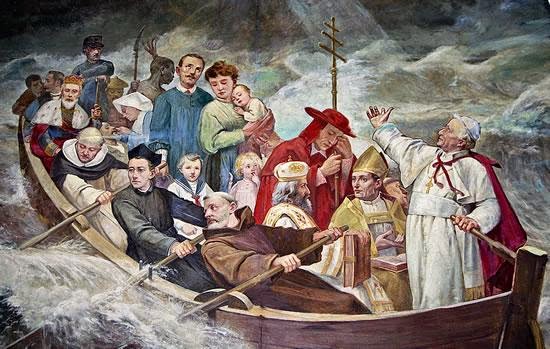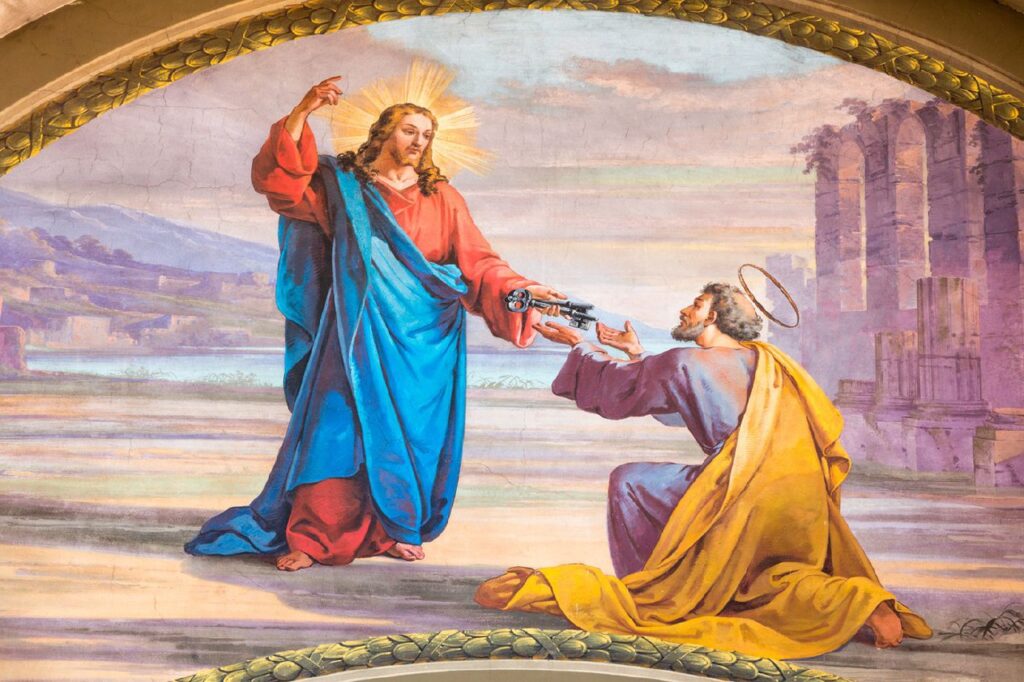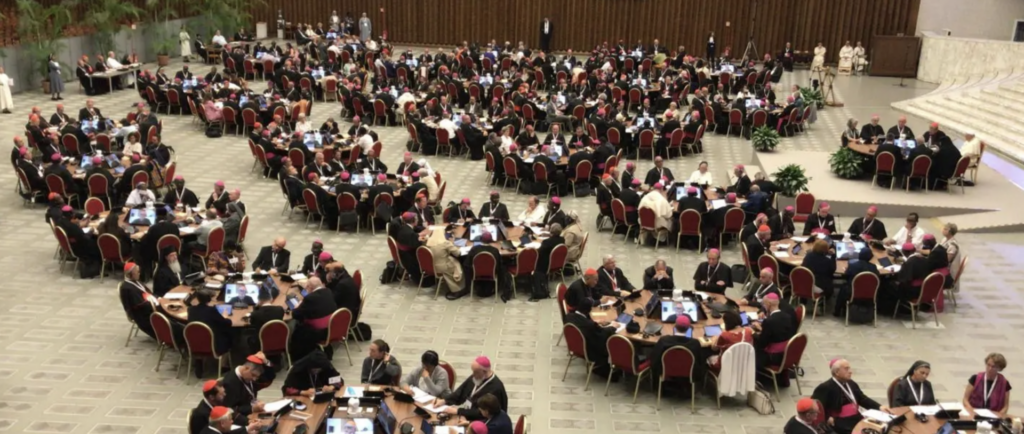SAFEGUARDING OF THE CATHOLIC FAITH
Fra' Francesco | Posted on |

The Faith is the most precious good on earth without which we cannot be saved.
Let us remember what we learned in our traditional catechism: the Catholic faith is an adhesion of the intelligence to the truths revealed by God and taught by the Church founded by Jesus Christ to which He gave authority and infallibility. It is the Church which assures us that the truths in which we believe are indeed the revealed truths. Faith requires adherence to all the truths it teaches us. Doubting, diminishing or even voluntarily denying a single one of these truths destroys the virtue of faith, because it is to reject the ability of the Church to teach the faith of the Apostles. Remove one of the columns from a cathedral and the whole building collapses.
This is a fortiori the case of false religions, where only a few shreds of truth remain. Unfortunately, the Second Vatican Council suggests, through its ambiguity, that these “truths” would be affected in themselves by a dynamism which would lead to plenary truth and salvation. Father Garrigou-Lagrange taught on the contrary that “the truths contained in false religions are not like the soul of the doctrine but like the servants of error”. In other words, to deceive someone you just have to mix truth and error. And Pius XII clearly taught that if it is true that, by exception, salvation can be achieved outside the visible limits of the Church, this can only happen in a strictly individual way by a special grace of God, and always through the true Church and not through the mediation of false religions. These, in fact, by their errors, distance men rather than bring them closer to the path of justification.

“You are Peter and on this rock I will build my Church”: these words contain the hierarchical principle.”
Today, more than ever, a protest movement within the Church is diminishing the faith by insidiously tending to undermine the very basis of its constitution: the hierarchical principle, the consequence of which is the inequality of members among which we distinguish:
The teaching Church, that is to say the Pope, the bishops subject to his jurisdiction, and the priests by delegation of their bishop.
The instructed Church, that is to say the faithful who “have no share in ecclesiastical authority; they are taught, governed and sanctified by their pastors. However, they can, especially in our time, powerfully assist them by helping them distribute Christian instruction to children, supporting them with their resources and defending them against the attacks and violence of impiety.” (Catholic doctrine, Canon Boulenger). And if the faithful receive illumination from the Holy Spirit they cannot take advantage of it to teach in the literal sense. For it was not to these latter that the function of teaching was entrusted but rather only to the Apostles and their successors to whom Jesus said: “go, teach all nations, baptizing them in the name of the Father, of the Son and the Holy Spirit”.
However, this does not diminish the value of the sensus fidei which, through the light of the Holy Spirit, makes the faithful recognize the truth, makes them discern the doctrinal or moral errors that endanger their faith, and gives them the strength to vigorously defend the doctrinal and liturgical Tradition of the Church.
This affirmation of its hierarchical constitution has already been watered down by the introduction of a false conception of the college of bishops thanks to the Second Vatican Council: “collegiality” where the college of bishops in communion with the Pope has become a second supreme power in the Church, while the Pope alone has “supreme authority” which he exercises alone, even by joining the college. The Second Vatican Council, through its innovation, thus elevated the college of bishops into a sort of democratic parliament, and the immediate consequence was the de facto power, exhorbitant and contrary to the hierarchical order, given to the Episcopal Conferences. “The episcopal conferences do not obey, but tyrannize the bishops who do not dare to protest against collective decisions, so that their authority is as if confiscated (cf. Mgr Lefebvre, Open Letter to Perplexed Catholics, ch. 13).” (see the article by Father Nicolas Cadiet, FSSPX). The synod on synodality further aggravates the upheaval of the hierarchical constitution of the Church. The preambles of this synod show that lay people, men and women, find themselves having de facto hierarchical power, through their participation with the right to vote in an assembly of the teaching Church, which is contrary to the Tradition of the Church. Furthermore, it appears that many of them have demands contrary to faith and morality: blessing of same-sex couples, right to communion for divorced and remarried people, diaconate or even priesthood for women, questioning of dogmas, etc. As for the exercise of power, the danger already exists, mutatis mutandis, in most dioceses, through an apparatus of management and pastoral responsibilities entrusted to lay people, men and women, who thus have de facto power. on all the clergy of the diocese, which upsets the hierarchical organization. Not to mention the new organization of the Roman dicasteries with lay people and nuns appointed to high management positions. By extension, the introduction of girls to the service of the altar is not trivial. It ignores the hierarchical order expressed in the liturgy. The acolytate is a minor Order, third degree towards the priesthood, and must only be accomplished by substitution by boys also called minor or great clerics.
The danger is therefore great to see new reforms attempt to destroy what remains of Tradition. Mgr Marcel Lefebvre had already denounced, in his declaration of November 21, 1974, how “All these reforms, in fact, have contributed and still contribute to the demolition of the Church, the ruin of the Priesthood, the annihilation of the Sacrifice and of the Sacraments, to the disappearance of religious life, to a naturalist and Teilhardian teaching in Universities, Seminaries, catechesis, teaching resulting from liberalism and Protestantism condemned many times by the solemn magisterium of the Church.
No authority, even the highest in the hierarchy, can force us to abandon or diminish our Catholic faith clearly expressed and professed by the magisterium of the Church for nineteen centuries.
“If it happens,” says Saint Paul, “that WE or an Angel from heaven teaches you anything other than what I have taught you, let him be anathema. » Gal. 1, 8. (Mgr Lefebvre November 21, 1974).
In this month dedicated to the Holy Rosary, let us turn to the Immaculate Heart of Mary to obtain from Her who is “strong as an army arrayed in battle”, to protect the Church from its enemies both from within and from exterior, and that the Bride of Christ once again shines before the face of the world, that she once again becomes the light of the nations and the ark of salvation for all men.
Let us add this striking testimony from Cardinal Ratzinger, who comes at the right moment to invoke the Most Holy Virgin: “When I was a young theologian,” he writes, “before and even during the sessions of the Council, I had… difficulty in understand the true meaning of a… famous expression…, namely the expression which wants Mary to be “victorious over all heresies”. Only today – in this period of confusion when all kinds of heretical deviations seem to come knocking at the door of authentic faith – today I understand that it was not an exaggeration of the devout, but of truths more valid than ever” (Interviews on Faith, Fayard 1985). And yet, unfortunately, the Cardinal, even when he became Pope, adhered to the proposals of the Second Vatican Council in contradiction with the previous magisterium.
May the almighty prayer of Mary, Mother of the Church, obtain victory for us from Jesus over anti-hierarchical heresy!

Cardinal Michael Czerny, prefect of the dicastery for the Service of Integral Human Development, was questioned on the Swiss portal Cath.ch: “The reform (of the Church), he said, has not stopped, it is in progress. There will be new results. But when we are at the beginning of a process, like the Synod on synodality, we cannot say what will come out of it at the end.” But, perhaps, an analysis of this assembly can leave us guessing: how many members have a firm attachment to the traditional doctrine of the Church?
